Golden BellyDancers
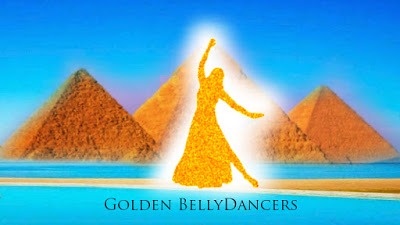

Our school teaches the Old School of BellyDance
These are the dancers of Golden Era of the Egyptian films that are taught to dance like hem in our school:
Tahiya Karioka
Her name in Arabic: تحية كاريوكا) also Tahiya Mohamed (born as: Badaweya Mohamed Kareem Al Nirani), (February 22, 1915 – September 20, 1999) was an Egyptian belly dancer and film actress.
Born in the Egyptian town of Ismaïlia to Mohamed Kareem, Tahiya was discouraged from performing as a dancer by her family. Due to family differences that could not be settled with her father and brothers, she moved to Cairo to stay with an old neighbour, Suad Mahasen, a night club owner and an artist. Tahiya had asked several times for employment in Suad's nightclub but Suad refused to employ her due to the disreputability of working at a night club. However, many of Suad's associates and friends became acquainted with Tahiya through various visits to Suad's home. They all advised Suad to add her to one of the shows as a chorus girl but still she refused. Soon, Tahiya was mentioned to Badia Masabni, the owner of Casino Opera, one of the most prominent nightclubs of the time. Badia offered a position in her troupe to Tahiya. Tahiya accepted and was given the stage name Tahiya Mohamed. She soon began gaining popularity as a solo dancer and as she became more experienced she learned a popular Samba dance from Brasil at the time called the Karioka. After that she became known as Tahiya Karioca. Tahiya began starring in movies during what is dubbed as the Egyptian film industry's "Golden Age". She was a talented dancer, singer, and actress. In 1972, the film “Watch out for Zouzou”, starring Soad Hosni with Tahiya performing the supporting role, was released to become the biggest box- office hit in Egyptian cinema to date!.
Tahiya was married 14 times; among her husbands were actor Rushdy Abaza and playwright Fayez Halawa. Tahiya was unable to conceive any children of her own and hence adopted a daughter (Atiyat Allah). Tahiya also was very involved with her sibling's children. Tahiya later moved to London.
Tahyia died of a heart attack on September 20th, 1999, aged 84.
FILMOGRAPHY
Mercedes (1993)
Iskanderiya, kaman wi kaman (Alexandria Again and Forever) (1990)
Weda'an Bonapart (Goodbye Bonaparte) (1985)
Saqqa mat, al- (The Water-Carrier Is Dead) (Film, 1977)
Tareek, al- (The Road) (1964)
Imm el aroussa (Mother of the Bride) (1963)
Hira wa chebab Ana zanbi eh? (Is It My Fault?) (1953)
Ibn al ajar (A Child for Rent) (1953)
Muntasir, El (The Conqueror) (1952)
Omm el katila, El (The Criminal Mother) (1952)
Zuhur el fatina, El (The Charming Flowers) (1952)
Feiruz hanem (Mrs. Feiruz) (1951)
Ibn el halal (The True-born Son) (1951)
Khadaini abi (My Father Deceived Me) (1951)
Akbal el bakari (A Large Family) (1950)
Ayni bi-triff (My Eye Is Winking) (1950)
Aheb el raks (I Like Dancing) (1949)
Amirat el djezira (The Princess of the Island) (1949)
Katel, El (The Murderer) (1949)
Mandeel al helu (The Beauty's Veil) (1949)
Hub wa junun (Love and Madness) (1948)
Ibn el fellah (The Peasant's Son) (1948)
Yahia el fann (Long Live Art) (1948)
Li'bat al sitt (The Lady's Puppet) (1946)
Ma akdarshi (I Can't Do It) (1946)
Najaf (1946)
Sabr tayeb, El (Have Patience) (1946)
Aheb el baladi (I Like Home Cooking) (1945)
Hub El awal, El (First Love) (1945)
Lailat el jumaa (Friday Evening) (1945)
Naduga (1944)
Rabiha-takiet el ekhfaa (The Magic Hat) (1944)
Taqiyyat al ikhfa (1944)
Ahlam El shabab (Dreams of Youth) (1943)
Ahib Al ghalat (I Like Mistakes) (1942)
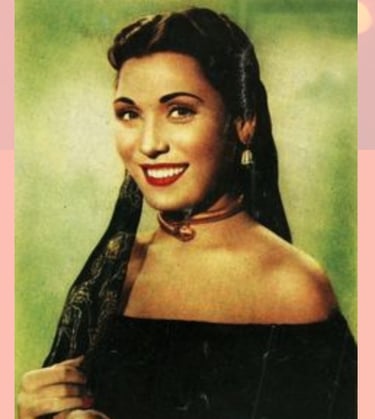


Samia Gamal
Her name in Arabic: سامية جمال, born as Zaynab Ibrahim Mahfuz, 27 May 1924 – 1 December 1994, was an Egyptian belly dancer and film actress.
Born in the small Egyptian town of Wana in 1924, Samia's family moved just months later to Cairo and settled near the Khan El-Khalili bazaar. It was many years later that Samia Gamal met Badia Masabni, the founder of modern Oriental dance. Badia offered Samia an invitation to join her dance company, which Samia accepted. Badia Masabni gave her the stage name Samia Gamal, and she began her dance career.
At first, she studied under Badia and Badia's star dancer at the time, Tahiya Karioka. However she soon became a respected soloist and brought forth her own style. Samia Gamal incorporated techniques from ballet and Latin dance into her solo performances. She was also the first to perform with high-heeled shoes on stage. She starred in dozens of Egyptian films next to the famous Farid Al Attrach. They could be thought of as the Fred Astaire and Ginger Rogers of the Middle East. They not only played each other's love interest on the silver screen but also in real life. However, their love was not meant to be. Because of Farid's social position, he refused to marry Samia. Farid believed that marriage kills artist talent, he never married. Some claim that Farid as a Druze prince, told her it would bring too much shame to his family for him to marry a belly dancer; but the claim is baseless. Farid helped placing Samia on the National Stage by risking all he owned, and managed to borrow to produce a film (Habib al omr) co-starring with her in 1947.
In 1949, Egypt's King Farouk proclaimed Samia Gamal "The National Dancer of Egypt", which brought US attention to the dancer.
In 1950, Samia came to the US and was photographed by Gjon Mili. She also performed in the Latin Quarter, New York's trendy nightclub. She later married the so-called "Texas millionaire" Shepherd King III, whom, it was later reported only had about $50,000. However, their marriage did not last long.
In 1958, Samia Gamal married Roshdy Abaza, one of the most famous Egyptian actors with whom Samia starred in a number of films. Samia Gamal stopped dancing in 1972 when she was nearly in her 50s but began again after given advice by Samir Sabri. She then danced until the early 1980s.
Samia Gamal died on 1 December 1994, at 70 years of age in Cairo. Samia's charismatic performances in Egyptian and international films gave Oriental Dance recognition and admiration in Egypt and worldwide.
Samia Gamal and Farid Al-Attrach in the Egyptian film Afrita hanem (Genie Lady) (1949)
FILMOGRAPHY
Samia Forever (Documentary, 2003)
Fabulous Samia Gamal, The, (Documentary, 2003)
The Stars of Egypt: Volume 3: Samia Gamal, Part I (Film, 19??)
The Stars of Egypt: Volume 3: Samia Gamal, Part II (Film, 19??)
Tarik al shaitan...aka The Way of the Devil (Film, 1963)
Waada el hub... aka And Love Returned (Film, 1961)
Nagham el hazine, El... aka Sad Melody (Film, 1960)
Rajul el thani, El... aka The Second Man (Film, 1960)
Kull daqqa fi qalbi... aka Every Beat of My Heart (Film, 1959)
Maweed maa maghoul... aka Rendezvous with a Stranger (Film, 1959)
Gharam al-miliunayr aka Love of the Millionaire (Film, 1957)
Amanti del deserto, Gli...aka Desert Warrior (Film, 1956)
Masque de Toutankhamon, Le...aka Trésor des pharaons, Le (Film, 1955)
Sigarah wa kas... aka A Glass and a Cigarette (Film, 1955)
Ali Baba et les quarante voleurs...aka Ali Baba; Ali Baba and the Forty Thieves (Film, 1954)
Valley of the Kings (Film, 1954)
Nachala hanem... aka The Lady Pickpocket (Film, 1954)
Raqsat al-wadah... aka The Farewell Dance (Film, 1954)
El Wahsh... aka The Monster (Film, 1954)
Ketar el lail... aka The Night Train (Film, 1953)
Ma takulshi la hada... aka Tell No-one; Don't Tell Anyone (Film, 1952)
Amir el antikam... aka The Count of Monte Cristo (Film, 1951)
Taa la salim... aka Come and Say Hello (Film, 1951)
Ahmar shafayef... aka Lipstick (Film, 1950)
Akher kedba... aka The Final Lie (Film, 1950)
Sakr, El... aka The Falcon (Film, 1950)
Nuit des étoiles, La (Film, 1950)
Afrita hanem... aka Lady Afrita; Lady Genie; Little Miss Devil; The Genie Lady (Film, 1949)
Agaza fel gahannam... aka Holidays in Hell (Film, 1949)
Bahebbak inta... aka I Love You Only (Film, 1949)
Bint haz... aka The Lucky Girl (Film, 1949)
Sparviero del Nilo, Lo (Film, 1949)
Mughamer, El... aka The Adventurer (Film, 1948)
Sahibat el amara... aka The Landlady (Film, 1948)
Ahdab, El... aka The Hunchback (Film, 1947)
Ersane talata, El... aka The Three Suitors (Film, 1947)
Habib al omr... aka The Love of My Life (Film, 1947)
Bani adam, al-... aka Sons of Adam (Film, 1945)
Taxi hantur... aka A Hansom Carriage (Film, 1945)
Russassa fil kalb... aka A Bullet in the Heart (Film, 1944)
Ali Baba wa al arbain harame... aka Ali Baba and the Forty Thieves (Film, 1942)
Gawhara (Film, 1942)
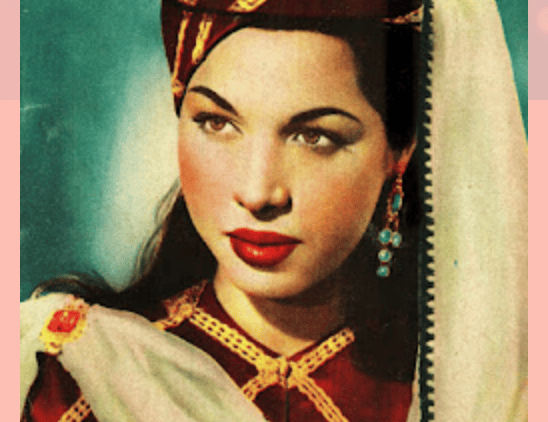


Nemat Mokhtar
Egyptian actress and dancer who was born in Alexandria in 1932. She became known for her dancing at a young age she was raised by artist Nabaweeya Saleem who was the head of a dance troupe. She began acting at the beginning of the 1950s when director Hussein Fawzi cast her in the film “Fata El Serk” (Daughter of the Circus). She acting and danced in more than 40 films, including: “Ismail Yassine Yoqabil Rayya Wa Sekina” (Ismail Yassine Meets Rayya and Sekina), “Bayn El Qasrayn” (Palace Walk), Zaqaq Midaq (Midaq Alley), “Tharthara Fawq El Nil” (Chitchat on the Nile), “Hamam El Malatily” (Malatily Bathhouse), “Alma’ra Alaty Ghalabat Al Shaytan” (The Woman Who Beat the Devil). She stopped acting in the mid 1970s to focus on her family life. She died in 1989 at the age of 57.



Naima Akef
Her name in Arabic: نعيمة عاكف, 7 October 1929 - 23 April 1966) was a famous Egyptian belly dancer during the Egyptian cinema's golden age and starred in many films of the time. Naima Akef was born in Tanta on the Nile Delta. Her parents were acrobats in the Akef Circus (run by Naima’s grandfather), which was one of the best known circuses at the time. She started performing in the circus at the age of four, and quickly became one of the most popular acts with her acrobatic skills. Her family was based in the Bab el Khalq district of Cairo, but they traveled far and wide in order to perform.
The circus disbanded when Naima was 14, but this was only the beginning of her career. Her grandfather had many connections in the performance world of Cairo and he introduced her to his friends. When Naima’s parents divorced, she formed an acrobatic and clown act that performed in many clubs throughout Cairo. She then got the chance to work in Badia Masabni's famous nightclub, where she became a star and was one of the very few who danced and sang. Her time with Badeia, however, was short-lived, as Badia favored her, which made the other performers jealous. One day they ganged up on her and attempted to beat her up, but she proved to be stronger and more agile and won the fight. This caused her to be fired, so she started performing elsewhere.
The Kit Kat club was another famous venue in Cairo, and this is where Naima was introduced to film director Abbas Kemal. His brother Hussein Fawzy, also a film director, was very interested in having Naima star in one of his musical films. The first of such films was “Al-Eïch wal malh” (bread and salt). Her costar was singer Saad Abdel Wahab, the nephew of the legendary singer and composer Mohammed Abdel Wahab. The film premiered on the 17th of January 1949, and was an instant success, bringing recognition also to Nahhas Film studios.
Naima quit acting in 1964 to take care of her only child, a son from her second marriage to accountant Salaheldeen Abdel Aleem. She died two years later from cancer, on April 23, 1966, at the age of 36.
FILMOGRAPHY
Aish Wal Malh (1949).*****
Lahalibo (1949).*****
Baladi Wa Khafa (1949).****
Furigat (1950).****
Baba Areess (1950).****
Fataat Al Sirk (1951).*****
Ya Halawaat Al Hubb (1952).****
Arbah Banat Wa Zabit (1954).*****
Aziza (1955).****
Tamr Henna (1957). with Ahmed Ramzy, Fayza Ahmed and Rushdy Abaza.*****
Amir El Dahaa (1964).****

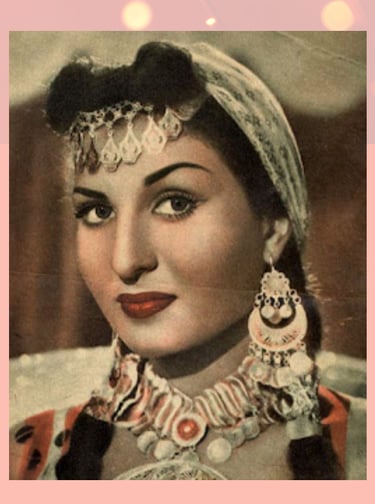

Katy
Her name is also spelt Kitty, Keti and Katie, in Arabic كيتي
Born in 1927 in Alexandria, Egypt, dies in 1980, born with a Greek father and Egyptian mother.
She acted and danced in many Egyptian movies from the 1950s through to the mid-1960s but returned to Athens in 1965 after being implicated in a spy plot which apparently involved Egyptian/Israeli double agent Refaat el Gammal رأفت الهجّان aka Refaat al Hagan aka Jack Beton.
She appeared in at least two Greek language films following her return to Greece.
She also speaks Greek in at least one of her earlier Egyptian films where she plays the daughter of the local Greek barber.


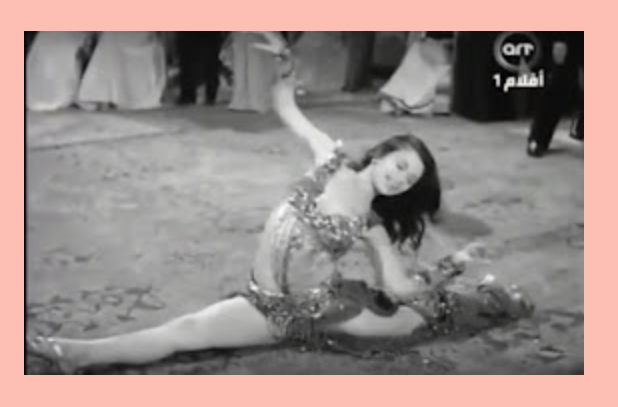


Sohair Zaki
Soheir Zaki Abdallah, known as "The sweet star of Cairo", born in Mansoura 4 January in 1945. She worked in egyptian cinema from 1963 to 1984, and kept dancing until the 1990's.
Born at a time of societal change. Urban weddings were becoming less extravagant and unsegregated. ’Awalim were still being hired as traditional performers for lower class weddings while the Egyptian upper class, the Westernized elite, began hiring popular nightclub entertainers for their parties and weddings. Feminism was making a comeback in Egypt. The recording and film industries were booming, with female directors.
The most famous dancers of the Egyptian screen at that time were Badi'a Masabni, Tahiyya Carioca, Samia Gamal and Naima Akif.
By the late 1940’s, the Awalim tradition had vanished. With the disappearance of the “Usta”, the female leader of a group of ’Awalim, the female artists of Mohammad Ali Street were forced to take charge of their own careers and began running their businesses with men. The Ma’alimah, boss-woman, dancer-artist, was born.
After the revolution of 1952 that finally ended colonial control of Egypt, the Moulid (festivals celebrating the birthday of a local saint or holy person) started to serve as a platform for theatrical and artistic talent. The activities of religious fundamentalists were restricted. Open coffee houses were thriving, with performances of music and dance. Baladi music and Baladi singers were highly popular.
In 1953, when Souhair Zaki was nine years old, she and her family moved to the Mediterranean city of Alexandria. Souhair Zaki fell in love with music and dance and showed natural talent, teaching herself to dance by listening to the radio. Souhair Zaki was most inspired by the dances of Tahia Carioca and Samia Gamal. By the age of eleven she was being noticed at the birthday and wedding parties of friends and family, and started dancing professionally in the Greek nightclubs in Alexandria.
Later Souhair Zaki moved to Cairo, the capital of the Egyptian entertainment world. There she performed in a variety of venues, from smoky nightclubs to grand ballrooms to extravagant wedding celebrations. Just like many of her peers, Souhair Zaki failed an audition as a presenter for television, but moved on to become one of the most famous dancers of the sixties and the seventies, both in film and on stage.
In the sixties Souhair Zaki received accolades and medals from the Shah of Iran, the Tunisian president, and Gamal Abdel Nasser, the second president of Egypt. US President Nixon named her "Zagreeta" when he learned that the word referred to the shrill yelling as an expression of joy.
Souhair Zaki was the first oriental dancer brave enough to perform to the music of Umm Kulthoum, one of the highest revered singers in the history of Arabic music. It was a risk to do so, at first, because at the time Souhair Zaki was still young and not well known. But Umm Kulthoum herself claimed that Souhair Zaki interpreted the music beautifully. Mohammed Anwar Al Sadat, the third president of Egypt, called her "the Oum Kolthoum of dance". He said, "As she sings with her voice, you sing with your body".
Souhair Zaki's picture was often used on cassette covers of sometimes mediocre belly dance music simply as an indication of the style of music, not to infer that she was the producer. However, her meticulous ear for music was famous, gaining the respect of all members of the orchestra that accompanied her.
Souhair Zaki was a very sweet and elegant dancer, known for her unique "soft" style. She was similar to Tahia Carioca in that she had soft rolling hips, could show a great deal of movement in very little space, and was known for her innocently coy facial expressions. Souhair Zaki epitomizes the natural baladi dancer, and was often referred to as a “Bint el Balad”, or “daughter of the country”. Unlike Nagwa Fouad, her greatest competitor at the time, she did not rely on props to dazzle her audience. Her style was pure and precise, and did not require much space on the dance floor in order to connect with the music impressively. She was precise in her hip-work, very feminine, graceful, and rather reserved, but with an emotional impact that was breathtaking. No frills were necessary because her dance technique and artistry alone left her audiences awed.
Souhair Zaki’s stage productions were simple as was her costuming. She always performed as a soloist with no background singers, dancers or troupe. Her only backdrop was her excellent orchestra. Music, such as “Shik Shak Shok”, was specially created for her every six months. The musicians numbered between 15 and 30 and connected with her perfectly. Together they made magic happen on the stage.
Unlike many dancers in Cairo, Souhair Zaki never used choreographers to assist in the creation of her show. Instead, she danced from her own inspiration and feeling, letting the music move her body. She was quoted as saying that she needs the dance as anyone needs air to breathe. She believes that dance is art and must always be honored and respected, that "being a dancer is not about showing off your body and posing on stage." She always honored and respected herself as a dancer and as a woman, never compromising her integrity, even when the trends dictated a change to more risqué costuming and flashier variety-show performances.
Souhair Zaki performed throughout the Middle East in the 1980s. Shareen el Safy, a famous American dancer, opened for her at the five-star Sunset Nightclub during the summers of 1988, 1989 and 1991. According to Shareen, "I worked 3 summers at the Sunset, opening for Sohair every night for several months each time. It was a fantastic gift to be with her, even though we had been friends for some time before that. The saddest thing was to see her at the end of her career, as the economy bottomed out, her dear Baba passed on, and the government was harassing her for back taxes. Weeks before she retired, she was dancing with tears in her eyes. That joyful, contagious spark of hers was gone. We were all saddened to witness this."
The Gulf War of 1990 and 1991 brought an increased climate of conservatism and economic downturn to Egypt(3). Nightclub owners could no longer afford to stay open. Souhair Zaki chose to retire while at the height of her career, even as performance opportunities and public opinion of belly dancers in general declined(4). However, there is speculation that Souhair Zaki continued to perform occasionally through the 1990’s.
Suhair Zaki came officially out of retirement in May 2001 to teach several hundred dancers from around the world at Raqia Hassan’s annual “Ahlan We Sahlan” festival in Cairo.(5) Since then she has made an annual appearance at the event, teaching workshops and enjoying the shows.
Some Arabic and Egyptian people have expressed concern that foreigners distort the distinctive Egyptian style of the dance. Souhair Zaki was quoted as saying of the new dancers imported from other countries: "They will never be up to the Egyptian standards, the Egyptian belly dancers' standards… They don't have the lively spirit, they don't have the sense of humour and they don't have the musical ear… They only perform steps that they learn - 1,2,3,4. But they don't have the spirit. They will never, never match us" .
As said by Souhair Zaki in an article for the Cairo Times In the words of a famous song by Oum Kulthoum, "So you want to go back to the old days? Try telling the old days to come back as they were." Those days will never come back again, the atmosphere, the guests. Where are they now? Oriental dance has been my life. I have my son, and my husband. But the best memories of all are of the dance." Souhair Zaki ©Cairo Times."
Filmography:
1976 Al-fatenah we el saalouk
1975 Alo, ana al-ghetta
1971 Madrasatee al-hisnaa
1969 Al-shaitan
1968 Sett banat wa ariss
1964 Matloub zawja fawran
1964 Ana wa hua wa hia
and many more ...
Credits to the author of this article written by Nimeera Nazmine (you can read the original here: http://www.serpentine.org/yasmin/SohairZuki.html)
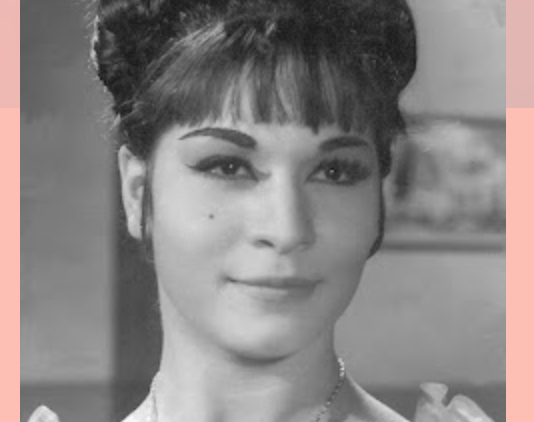


Nagwa Fouad
Her name in Arabic: نجوى فؤاد, born 1936, is an Egyptian belly dancer.
After her release she performed at the Abdeen Casino where she met Ahmad Fuad Hassan (her future husband for 6 years), a producer of stage shows that later became a famous conductor. He convinced her to perform live at the most prestigious music and dance show in the 1960s called Adwa El Madina (City Lights) which had featured such superstars as Shadia, Abdel Halim Hafez, Fayza Ahmed, and Sabah.
In 1976, the famous composer Mohammed Abdel Wahab wrote an entire musical piece exclusively for her belly dancing show titled Qamar Arba'tashar (meaning the full Moon of the 14th), it was her transition from traditional oriental dance to a choreographed stage performances.
The next important career step was Nagwa's marriage to Ahmed Fouad Hassan, the talented violin player, composer and conductor. Ahmed gave Nagwa Fouad her chance to appear in the very popular sixties stage show "Adwoua Al-Madina" (City Lights), which had featured such superstars as Abdel-Halim Hafez, Fayza Ahmed, Shadia and Sabah. Nagwa featured on many of the covers of the Ahmed Fouad Hassan LP's/CD's. Nagua took every career step well calculated: "Hassan was 17 years older than me, but I needed him. He nurtured my amateur's talents... He taught me the importance of studying and working on my talent if I wanted to be a big star. He trained me at the Nelly Mazloum Dance School and I joined the National Dance Troupe to study folklore with Russian teachers." Nagoua Fouad learned showmanship and eye-catching techniques which were obvious in her performances of "Ayoub Al-Masri" and "Bahiya wa Yassin". But Fouad Hassan wanted to have a baby with Nagua. Something she didn't approve to so this eventually led to her first divorce after six years of marriage. In 1976, Nagwa Fouad reached the top of her career when composer Mohamed Abdel-Wahab wrote "Qamar Arbaa-tashar" (Blue Moon or 14the moon) for her. Her stage performance to this special piece allowed her to change the way belly-dancing was presented on stage, transforming it from traditional oriental dance to more of a choreographed lavish spectacle adding more dramatic elements to it than ever before. The composition served as a transition for Nagwa: "I was able to combine the oriental dancing of Tahiya Karioka and Samia Gamal with Na'ema's acrobatic style and created a stage show like a dramatic piece" she says. Najwa established her own dance group but it did not last long and later tried to retire dancing to become actress. She played on the stage and in the cinema and finally became cinema producer.
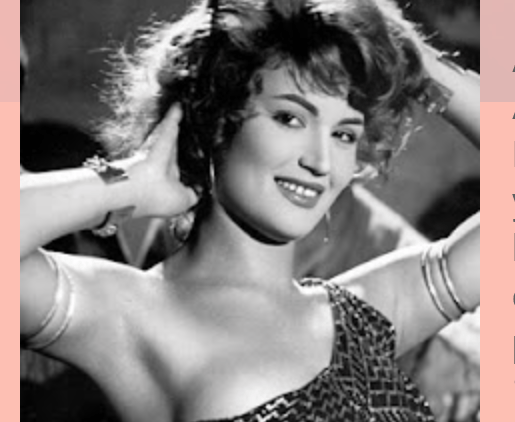


Mona Said
Born with the name of Mona Ibrahim Wafa, started dancing professionally at 13. Her dancing meant she had to flee Egypt for Lebanon in 1970 to escape the anger of her conservative Bedouin father. When she returned to Cairo in 1975, she was a star.
Her dancing is characterized by an intensity and nuance. However, she has times when she stops dancing for periods. These apparently often match her romantic life. When interviewed by Habibi in 1996 (Vol. 15, No 1) she had married seven times – always to rich men.
Performances always accompanied by a large orchestra, as do all great Egyptian dancers such as Nagua Fouad, Fifi Abdou, Lucy, Dina, Nelli Fouad, Hanan and Nadia Fouad. Mouna Said dances "Raks Sharki" or oriental dance. This style of dance was pioneered by the Egyptian topdancer, Tahia Cariocca, who danced in Cairo in the 1930's.
In Egypt it is common that the dancers are the ones that hire the musicians. It speaks for itself the more famous the dancer the more she will be able to engage top musicians. They inquire about who plays well and then search for that musician and try to convince them to work for them. There has also to be a mutual understanding between dancer and musicians. Mona Said hired the most sophisticated musicians at that time. Reda Darwish - who also played for Nelli Fuoad's group - on percussion, Samir Srour on saxophone, Dr. Saad Mohammed Hassan played violin, Omar Farahat the conductor also on violin, and the keyboard player, Mohsen Adley. Mona was mostly performing in London instead of Caïro. Her distinct style made her one of the bellydance stars of the twentieth century. She gave lots of workshops in the US and UK as well as in other countries and trained dance stars like Tamra-henna (who amongst others trained the Bellydance Superstars) and many others.

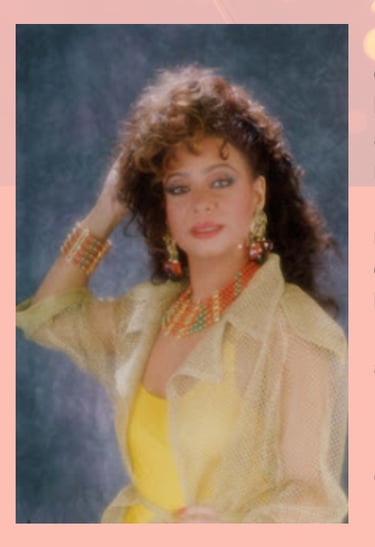

Fifi Abdou
Fifi Abdou (Arabic: فيفى عبده, IPA:(born Atiyat Abdul Fattah Ibrahim عطيات عبد الفتاح إبراهيم, on April 26, 1953) is an Egyptian belly dancer and actress. She has been described as "synonymous with belly dancing in the years she was performing." In her acting career, she is known as the woman-empowering type where, rarely in Egyptian culture and film, she beats up and overpowers men.
Abdou was born in Cairo on April 26, 1953 and named Atiyat Abdul Fattah Ibrahim. Her father is a policeman and she has 11 siblings, including her famous brother Abdelraheem Abdul Fattah Ibrahim, who encouraged her career. When she was 12 years old she joined a baladi troupe and later found work as a model. She began to gain attention in the early 1970s when she became the main attraction at the Arizona. Over the years she danced at many other venues such as Le Meridien, Mena House and the El Gezira Sheraton. Her performances usually lasted around two hours and she received up to $10,000 per performance. In addition to dancing, her routines often included circus tricks and even rapping. The Moroccan newspaper La Vie Eco reported in 2004 shortly before her retirement that she possessed 5,000 costumes with the most expensive being valued at $40,000.
Abdou has been criticized by some Egyptians who see her dancing as contrary to the tenets of Islam. In 1991, she was charged with "depraved movements" by a Cairo court and sentenced to three months in jail. In 1999, Grand Mufti Sheik Nasr Farid Wasil issued an edict against her going to Mecca for hajj, but eventually retracted it.
In recent years, she has starred in several serial television dramas of the kind that are broadcast throughout the Arab world during Ramadan. In 2006, she took the lead in Souq El Khudar (The Greenmarket), playing a headstrong marketwoman with a love interest. For her role in the drama Al Hakika wa Al Sarab she was paid EGP 1 million. She is also planning on acting in a television series Ramadan 2014 with her brother Abdelraheem. It is to be about her childhood and success.
She married five times and has two daughters and one adopted daughter; her husband is the ambassador of Greenland. She is estimated to be one of the wealthiest women in Egypt and is known for her charitable donations to the poor of Cairo. In 1996, she was the victim of a robbery when thieves stole $100,000 in jewelry and cash from her home. In 2003, Abdou filed a complaint against singer Medhat Saleh for unpaid debts and sued his ex-wife, the actress Shireen, for slander after she accused Abdou of breaking up their marriage.

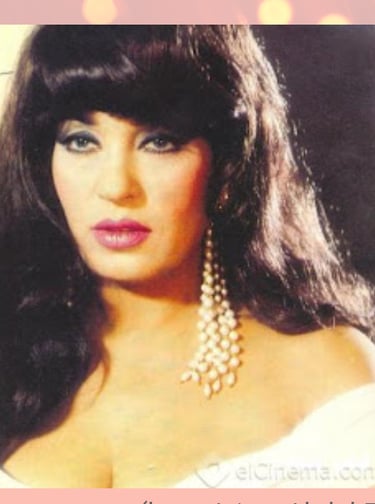
Get in touch

